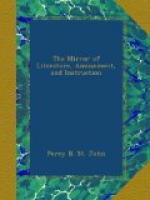Because of the vegetable transpiration condensed by the coldness of the night. It was long thought that they were produced by dew; but Mushenbroek first proved the above, by conclusive experiments. He intercepted all communication between a poppy and the ambient air, by covering it with a bell; and between it and the earth, by covering the vessel in which it grew with a leaden plate. Next morning the drop appeared upon it as before—Richard.
One of the hydrangea tribe perspires so freely, that the leaves wither and become crisp in a very short space of time, if the plant be not amply supplied with water: it has 160,000 apertures on every inch square of surface, on the under disk of the leaf.
Why is more or less of a gummy, resinous, or saccharine matter found in every tree?
Because it is formed by branches of those returning vessels that deposit the new alburnum.
Why is it inferred that these juices must be prepared in the plant itself, by various secretions, and changes of the fluids which it absorbs?
Because we find, that in the same climate, nay, even in the same spot of ground, rue has its bitter—sorrel its acid—and the lettuce its cooling juices; and that the juices of the various parts of one plant, or even of one fruit, are extremely different. Sir James Smith mentions the peach-tree as a familiar example. “The gum of this tree is mild and mucilaginous. The bark, leaves, and flowers, abound with a bitter secretion, of a purgative and rather dangerous quality, than which nothing can be more distinct from the gum. The fruit is replete, not only with acid, mucilage, and sugar, but with its own peculiar aromatic and highly volatile secretion, elaborated within itself, on which its fine flavour depends.”—Introduction to Botany, 6th edit.
Why are these juices readily found in the bark?
Because they appear to be matured, or brought to greater perfection, in layers of wood or bark that have no longer any principal share in the circulation of the sap. Thus, the vessels containing them are often very large, as the turpentine cells of the fir tribe, in all the species of which these secretions abound. The substance from which spruce-beer is made, is an extract of the branches of the Abies Canadensis, or Hemlock Spruce; a similar preparation is obtained from the branches of Dacrydium, in the South Seas.
Why, in the spring, is the herbage under trees generally more luxuriant than it is beyond the spread of their branches?
Because the driving mists and fogs becoming condensed on the branches, cause a frequent drip beneath the tree not experienced in other places; and thus keep up a perpetual irrigation and refreshment of the soil.
Why are certain plants useful or injurious to others that grow in their vicinity?
Because of certain fluids which the roots excrete from their slender extremities; and in this manner the likings and antipathies of certain plants may be accounted for. Thus, it is well known that the creeping thistle is hurtful to oats, erigeron acre to wheat, scabiosa arvensis to flax, &c.




